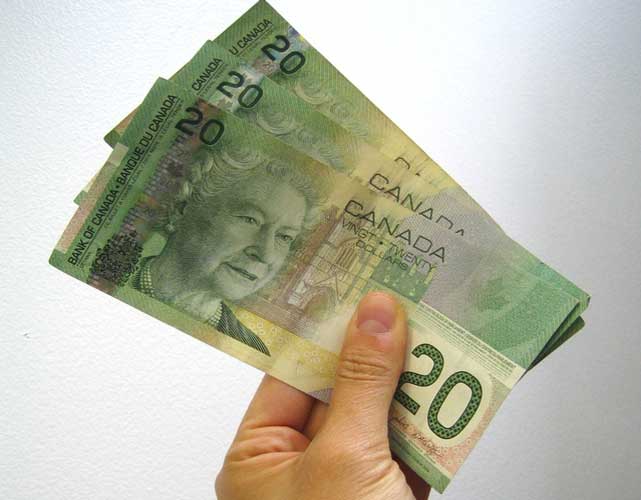Canadian Dollar Gains Momentum: Trump's Influence On CAD-USD Exchange Rate

Table of Contents
Trump's Trade Policies and their Lingering Impact on the CAD-USD Exchange Rate
Trump's trade policies significantly impacted the CAD-USD exchange rate, leaving a lasting legacy on the currency markets. Two key areas highlight this influence: the NAFTA/USMCA renegotiation and the imposition of tariffs.
The NAFTA/USMCA Renegotiation:
The renegotiation of the North American Free Trade Agreement (NAFTA) into the United States-Mexico-Canada Agreement (USMCA) created considerable uncertainty for investors.
- Uncertainty during negotiations: The unpredictable nature of the negotiations fostered significant volatility in the CAD-USD exchange rate. Investors were hesitant to commit capital due to the fear of unfavorable outcomes impacting both the US and Canadian economies.
- The eventual USMCA agreement: While the final USMCA agreement brought some resolution, the protracted negotiations had already taken a toll on investor confidence. The lingering effects of this period of uncertainty continue to influence market sentiment.
- Market reactions: The CAD initially weakened against the USD during the height of the NAFTA renegotiations, reflecting the economic uncertainty. However, the eventual agreement, while not a complete victory for either side, helped stabilize the exchange rate, though not entirely erasing the effects of the prior volatility. The overall impact was a period of decreased confidence followed by a gradual recovery.
Tariffs and Trade Wars:
Trump's imposition of tariffs on various goods, including those imported from Canada, significantly impacted the CAD-USD exchange rate.
- Impact on Canada: Tariffs on Canadian goods, such as lumber and aluminum, negatively impacted the Canadian economy, creating headwinds for the CAD. These economic sanctions led to increased costs for Canadian businesses and dampened export growth.
- Market Volatility: The trade disputes between the US and Canada introduced significant market volatility. The uncertainty surrounding future trade relations made it difficult for investors to predict the direction of the CAD-USD exchange rate.
- Short-term and Long-term Effects: While some of the tariffs were eventually rolled back or modified, the long-term effects of these trade wars continue to influence the perception of the Canadian economy and its currency. The initial negative impact on the CAD has been partially offset by subsequent economic recoveries, but lingering uncertainties remain.
Trump's Economic Policies and their Influence on the CAD-USD
Beyond trade, Trump's broader economic policies also influenced the CAD-USD exchange rate.
Fiscal Stimulus and its Global Ripple Effect:
Trump's fiscal policies, including significant tax cuts and increased government spending, stimulated the US economy.
- Impact on USD: This stimulus initially strengthened the USD, making it more attractive to foreign investors. The increased demand for USD put downward pressure on the CAD.
- Relative Economic Strength: The relative economic strength of the US compared to Canada played a key role in determining the CAD-USD exchange rate. A stronger US economy generally attracts more investment, strengthening the USD relative to the CAD.
- Interest Rates and Monetary Policy: The Federal Reserve's response to Trump's fiscal policies, including potential interest rate adjustments, also influenced the exchange rate. Changes in interest rates directly affect currency values through capital flows.
Uncertainty and Market Volatility:
Trump's unpredictable pronouncements and policy shifts created significant market uncertainty, impacting investor sentiment and the CAD-USD exchange rate.
- Investor Sentiment: Uncertainty breeds risk aversion. Investors, unsure of the future direction of US policy, often moved to safer haven currencies, impacting the demand for USD and, consequently, the CAD-USD rate.
- Uncertainty and Fluctuations: Trump's unpredictable behavior led to periods of heightened volatility in the currency markets. Sharp fluctuations in the CAD-USD exchange rate became more frequent during periods of heightened political uncertainty.
- Safe Haven Currency: The USD, often viewed as a safe-haven currency during times of global uncertainty, benefited disproportionately from this, further pressuring the CAD.
Other Factors Influencing the CAD-USD Exchange Rate Beyond Trump's Influence
While Trump's policies played a significant role, other factors influenced the CAD-USD exchange rate.
Commodity Prices (Oil and other resources):
Canada's economy is heavily reliant on commodity exports, particularly oil.
- Oil Prices and CAD: Fluctuations in oil prices directly impact the value of the CAD. Higher oil prices generally strengthen the CAD, as it increases Canada's export earnings.
- Correlation between Commodity Prices and Currency Strength: The relationship between commodity prices and currency strength is generally positive for commodity-exporting countries like Canada.
- Supply and Demand: Global supply and demand for commodities influence prices, and these price changes have a direct impact on the value of the CAD.
Interest Rate Differentials:
Differences in interest rates between the US and Canada influence capital flows and the CAD-USD exchange rate.
- Capital Flows: Higher interest rates in one country attract foreign investment, increasing demand for that country's currency. Differences in interest rates between the US and Canada affect capital flows, influencing the CAD-USD exchange rate.
- Monetary Policy of Central Banks: The monetary policies of the Bank of Canada and the Federal Reserve, including interest rate decisions, play a crucial role in determining the relative attractiveness of each currency to investors.
- Currency Appreciation/Depreciation: Higher interest rates in Canada compared to the US would, all else equal, tend to strengthen the CAD against the USD.
Conclusion
While Trump's actions significantly impacted the CAD-USD exchange rate through trade policy, fiscal stimulus, and market uncertainty, other factors like commodity prices and interest rate differentials also played a crucial role. The legacy of his presidency continues to influence currency markets. Understanding the complex interplay of these factors is crucial for anyone involved in forex trading or international business. Stay informed about the CAD-USD exchange rate and its drivers to make informed decisions. Continue to monitor the Canadian dollar's strength against the USD and the evolving impact of past policy decisions on future trends.

Featured Posts
-
 Sakiewicz O Solidarnosci I Republice Kluczowe Wyroznienia I Ich Znaczenie
May 03, 2025
Sakiewicz O Solidarnosci I Republice Kluczowe Wyroznienia I Ich Znaczenie
May 03, 2025 -
 Winning Lottery Numbers Wednesday 16th April 2025
May 03, 2025
Winning Lottery Numbers Wednesday 16th April 2025
May 03, 2025 -
 Fortnite Cowboy Bebop Skins Faye Valentine And Spike Spiegel Bundle Price
May 03, 2025
Fortnite Cowboy Bebop Skins Faye Valentine And Spike Spiegel Bundle Price
May 03, 2025 -
 Manfaatkan Cangkang Telur Pupuk Alami Dan Sumber Kalsium Untuk Pertumbuhan Optimal
May 03, 2025
Manfaatkan Cangkang Telur Pupuk Alami Dan Sumber Kalsium Untuk Pertumbuhan Optimal
May 03, 2025 -
 Reform Uks Strategic Choice Why An Snp Win Is Preferred
May 03, 2025
Reform Uks Strategic Choice Why An Snp Win Is Preferred
May 03, 2025
